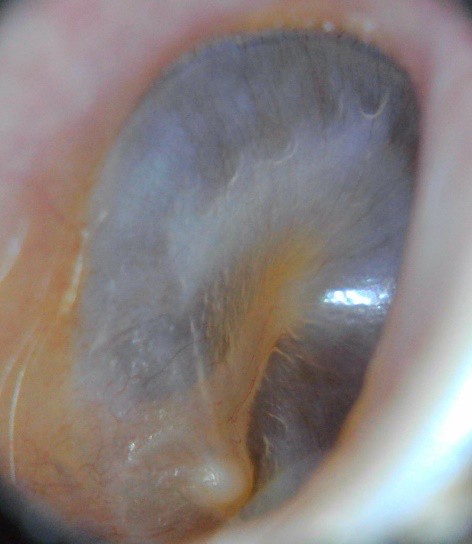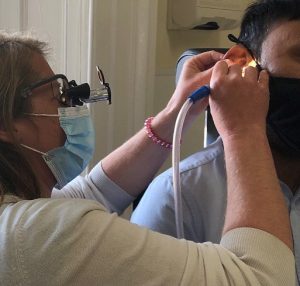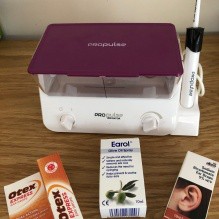Ear Examination & Wax Removal
Ear Examination
Prior to any wax removal the Audiologist will perform an Ear Exam. The aim of this examination is to assess the amount and position of any wax and to support the clinical decision-making process regarding any other interventions to be carried out.
Observations from both ears will be documented and note if the eardrum is visible, if there is any wax (amount and colour), ear discharge, redness, scaliness, swelling of the ear canal and note if any wax softening agents have been used.
The Audiologist has a camera that allows the client to see on the laptop a glimpse of their ear canal and ear drum/evidence of ear wax/debris if the ear canal is wide and straight enough to allow.

Otoscopic examination of a normal tympanic membrane using the video otoscope
Following examination the Audiologist can use clinical judgement on the best method for wax management and removal. Informed consent is then needed for any Ear Care Procedures which include Aural Microsuction and Ear Irrigation and/or Instrumentation.
Wax Removal
The benefits of ear wax removal include;
- reducing the feeling of block/occluded sensation and/or tinnitus
- allowing visualisation of the eardrum and ear canal during ear examination
- reducing the likelihood of hearing reduction on a baseline hearing test
- allowing procedures like hearing tests, tympanometry, impression taking and hearing aid fitting with probe microphone measurements to be performed
- reducing the likelihood of feedback/whistling due to wax in situ of ear canal
Option 1 – Aural Microsuction
Ear (aural) microsuction is the gentle, comfortable and safe way to clean ear canals partially or fully blocked with wax/debris. The ear canals are cleared using the magnified view of a surgical microscope and a tiny vacuum cleaner and/or tiny instruments.
The client sits on a comfortable chair whilst the Audiologist sits alongside on a wheely stool. The Audiologist gently holds the outer ear (pinna) to allow the ear canal entrance to open, sometimes they use a plastic funnel to gain the best view. The microscope is then focused into the ear canal entrance.
The suction used is quite noisy and can feel a bit tickly when in use. The instruments used help scoop out any excess or difficult to remove wax. The magnified goggles allow the Audiologist to assess the ear canal and eardrum and removal wax/debris carefully and safely.

Option 2 – Ear Irrigation
Ear irrigation uses an electronic ear irrigation machine to remove ear wax. This machine contains a storage reservoir unit for water and a hand held nozzle/ear irrigation syringe which pumps water into the ear canal at a controlled and steady rate in an attempt to dislodge and flush out ear wax. The water used within this procedure is warmed to a comfortable temperature.
Ear irrigation typically takes between 15-30 minutes to perform. This can vary depending on the amount and type of ear wax, how deep the ear wax is inside the ear canal and whether you are having one or both ears treated. It is usually performed with the person sat still and their head slightly tilted so the affected ear is facing upwards. This is to help water travel down the ear canal as it is being squirted. As the water runs back out, a metal cup-shaped basin is placed beneath the ear to collect it and any ear wax it has flushed out.

Option 3 – Ear Instrumentation
Sometimes the easiest way to get rid of ear wax is with the use of specialist instruments. Using high-powered magnification or a headlight for external illumination it is often possible to remove wax and other obstructions without the need for suction or water. All specialist instruments are of the highest quality and sterilised to approved standards. If a small amount of wax is not too deep into the ear canal, an ear hook can be used to draw the wax out. Alternatively hard crusty wax can be gently manoeuvred out of the ear canal using crocodile forceps. If this treatment becomes uncomfortable, a clinical judgement will be made to try an alternative, e.g, olive oil drops for a week. The client can then return for Aural Microsuction, Ear Irrigation or further instrumentation. Excessive soft wax or crumbly wax and debris can be wiped out with cotton wool wound onto a Jobson Horne probe or removed by Microsuction or Irrigation.
NB. All clinical tests are performed are compliant with the British Society of Audiology Recommended Procedures found at: www.thebsa.org.uk
Copyright © 2021
Poynton Ear Care
All rights reserved.
